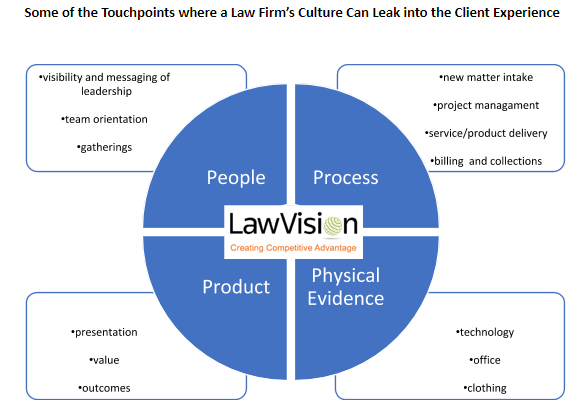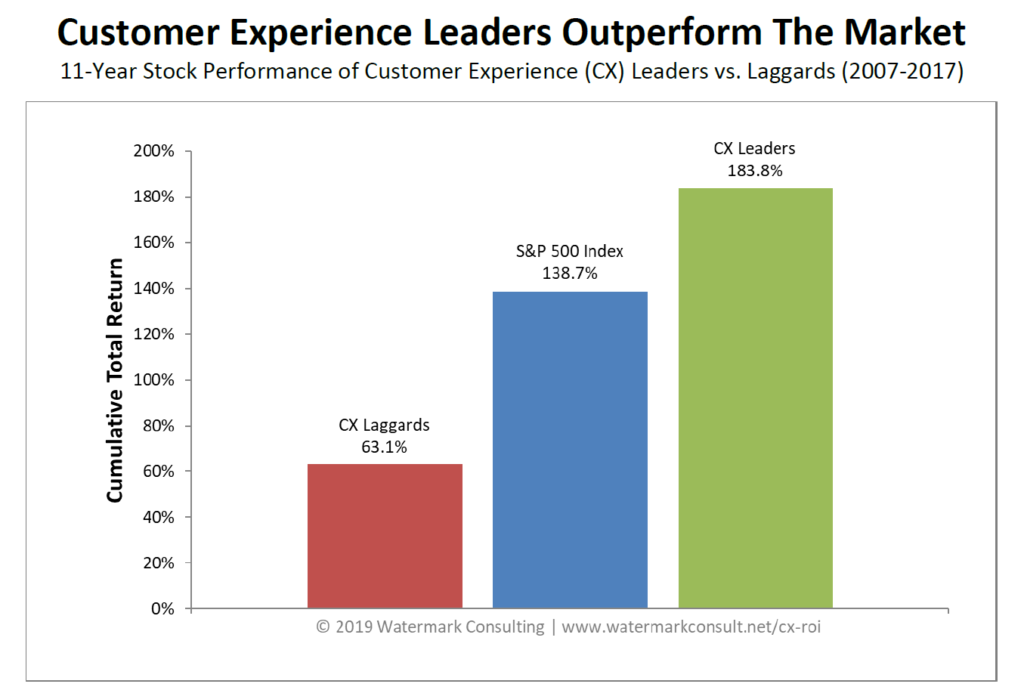Posted In: Client Service, Culture & Diversity, Leadership Support & Development, Team Performance
Law Firm Culture Leaks into the Client Experience
By Yvonne Nath and guest author Cole Silver, Chief Client Officer at Blank Rome LLP
You can detect a firm’s culture through its cultural artifacts and practices. Cultural artifacts are physical evidence, such as posters on the walls, the website, and what people wear; practices are the routine behaviors, such as how people interact within meetings, how they handle conflict, and what they celebrate and reward.
A law firm’s artifacts and practices appear at numerous touchpoints between firm employees and clients. In the figure that follows, we list a mere handful of the numerous touchpoints where a law firm’s culture, through its artifacts and practices, can leak into the client experience, for better or worse.
Our guest author, Cole Silver, worked as General Counsel to several high growth companies for nearly 25 years prior to joining Blank Rome as Chief Client Officer. Having worked on both sides of the law firm and client relationship, Cole is going to talk about some of the ways he has seen law firm culture affect the client experience.
Cole: Thanks, Yvonne. The management “guru” Peter Drucker once said: “Culture eats strategy for breakfast.” In lots of ways, he’s right, especially in a law firm where management is run as a partnership. No matter the business, we all know that when human capital is honored and engaged, they will go the extra mile for clients and the firm. And when clients are provided a memorable first-class experience, they will reciprocate through enduring loyalty and by referring their friends to the firm. A “client-centric” or “outside-in” culture, where decisions are made with the clients’ benefit in mind, also provides the firm an enduring brand (which is rare in the legal market) and a strong competitive advantage.
If you still need convincing, look to this chart from the CX ROI Study from Watermark Consulting (a customer experience advisory firm) for the business case for improving the client experience:
While most clients don’t really care about a firm’s culture unless it affects them, they know when it all works together. Achieving this “client-culture” nirvana is not always easy as certain cultural issues get in the way. I’ll briefly discuss some of these cultural issues that affect the client experience at key touchpoints.
Cultural issue: a law firm’s compensation system can incentivize the wrong behaviors which can affect team orientation and the service/product delivery and outcomes
Most clients prefer a team approach yet, in many instances, lawyers don’t always work as a team because their compensation model doesn’t incentivize teamwork. Compensation systems vary by law firm, so it is important to note that this is not the case at all firms. If a firm’s compensation system incentivizes eat-what-you-kill behaviors rather than collaboration, it naturally hinders a holistic approach to the client’s problems. This concept of a “team” or “account management” approach is essential for so many reasons, many of which are pronounced by current events like health and safety issues, diversity and inclusion, client succession and the aging of relationship partners, technology that opens an entire new area of risk, and the economic disruption caused by the pandemic. All of these convergent issues demand team coordination. Clients want their lawyers to bring to them enterprise-wide solutions that only an effective team can deliver. Just look at the Big 4 and see how effective they can be. If firms can change the strict compensation and “ownership” of the client structure, the culture and the clients will benefit…and so will the firm!
Cultural issue: some lawyers are unwilling to go to the emotional side
One of the keys to being an effective leader is to treat people with dignity and respect, to make each person feel as if they are the most important person in the world. Some lawyers are uncomfortable addressing the emotional side of human behavior. This is a mistake. How often do people within the law firm say “I appreciate you and your good work” or “I trust and respect you” to their colleagues or staff? Externally, attorneys should also take the time to tell their clients (often) how appreciative they are that the client trusted them enough to hire them. Clients have many options today. Companies that provide this emotional link with clients and employees consistently outperform their competitors financially and in other value-based metrics.[1]
Cultural issue: many firms, especially smaller firms, are primarily law practice-minded, not business-minded
Lawyers were never trained in marketing, business development, pricing, business analytics, or project management. Yet today they are being asked to understand these and other disciplines. They are required to find the business, manage the client through the firm’s policies, sit on firm committees, do the work, bill it, and collect it. To me, this is not an efficient way to run a business. What’s more, most lawyers are not business-minded, which keeps them from being truly client-centric. That’s why I strongly believe that each lawyer should do a secondment at a client’s office or a sabbatical in the business world at some time in their career. Only when you’ve walked in your client’s shoes, can you truly understand and help them.
The failure to view the world from the “client’s eyes” causes other problems as well.
Matter management, for instance. When the client learns through a bill that there were 3 associates and a paralegal listening in unannounced on a call or several lawyers reviewed several drafts of a lengthy single-spaced memo written in legalese, trust is diminished…as is the client experience. There are many types of matter management issues where the lawyer’s requirement to bill hours conflicts with the client’s desire for an expeditious and inexpensive resolution. So, it’s really important that the law firm has a clear understanding of the client’s goals and objectives with respect to all key areas including strategy, communication, risk tolerance, budgeting, etc. And the only way you can be sure that you’re providing a positive client experience is by asking and having a regular feedback loop with the client. Only in this regard, can you ensure you’re at least meeting, if not exceeding, the client’s expectations and are in front of the curve on new issues.
Peter Drucker also said, “The purpose of business is to create and keep a client.” Without clients, you have no business. So, it makes total sense to put the client at the center of your business, your culture, and your strategy. This client-centric purpose sets the foundation for the firm’s brand, a rallying cry for employees, and a mission and vision for the future. And it all starts with leadership and a client-centric attitude.
Yvonne: Thanks, Cole! Improving the client experience doesn’t happen as easily as it should because behaviors must change for improvements to occur. Change initiatives often fail when firms do not understand and address the root causes of cultural issues that hold people back from making improvements. If your firm is having trouble motivating employees towards a client-centric purpose, feel free to reach out to me, Yvonne Nath, at ynath@lawvision.com. I can help you identify bottlenecks to cultural change and levers for improvement.
About the Authors
Cole Silver has over 25 years of experience as a General Counsel to several high growth companies. He brings an insider’s view of clients’ key legal concerns and what they want and expect from their outside counsel. He has authored books and trained hundreds of professionals in the areas of client development and service.
Yvonne Nath is a consultant with LawVision where she practices within the Strategy team at the intersection of law firm culture and strategy to help firms build strategies and implement change. She has her master’s degree in law firm management and is accredited in organizational culture.
[1] https://hbr.org/2015/11/the-new-science-of-customer-emotions


No Comments